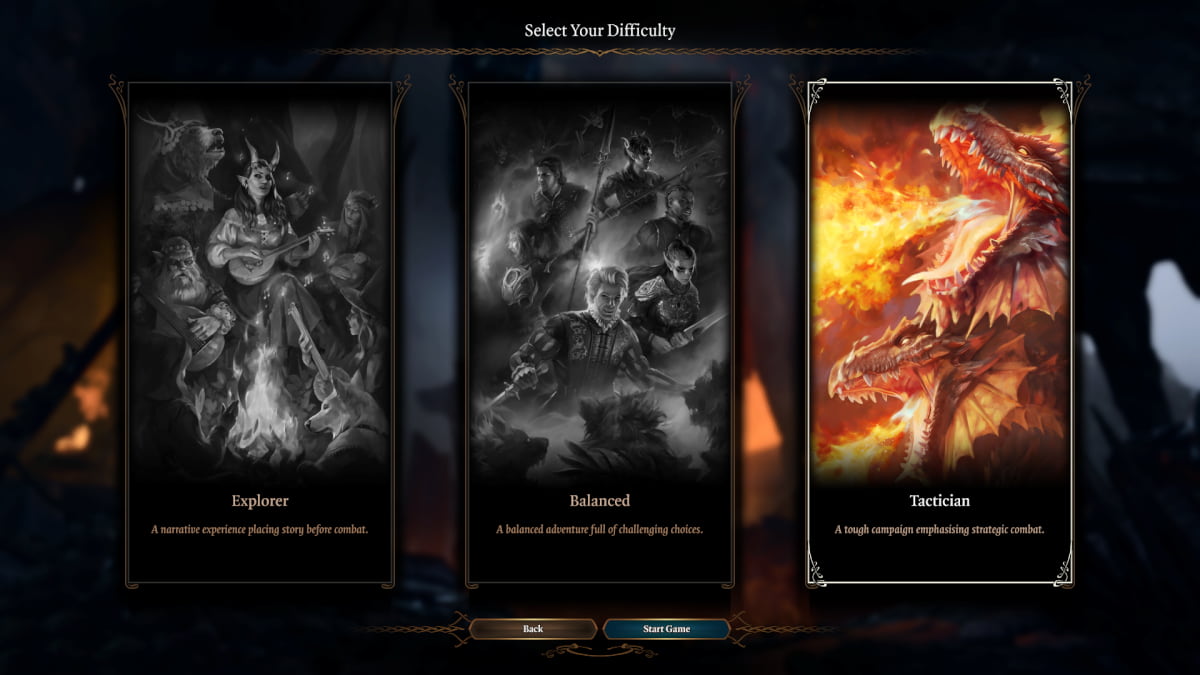All the best RPGs give the player a choice of difficulty setting, and Baldur’s Gate 3 is no different. Before you’ve even gotten to choosing a character class or seen any fancy cut scene, you need to decide whether you want to choose Explorer (easy mode, where the story has more emphasis than fighting), Balanced (more balanced and challenging), or the toughest option, Tactician. Below you’ll find my guide explaining just what choosing the Tactician difficulty level in BG3 entails.
What are the difficulty differences in BG3?

Baldur’s Gate 3’s own description says Tactician mode will give you a tough campaign emphasizing strategic combat. But what does this mean in real terms? Firstly, enemy HP will be significantly higher throughout the campaign. But in addition to this, you are likely to see more environmental items to use (or have used against you), such as barrels, while enemy units will have their AI better-tuned, meaning they are more likely to attack your squishier units first.
Here are the full details on what to expect from Tactician in BG3:
- Enemy HP: You’ll see a 30 percent rise in enemy HP from Explorer to Balanced and a further 30 percent rise from Balanced to Tactician.
- Hit chance: Enemies have a five percent greater chance to hit on Balanced, as compared to Explorer. However, this doesn’t rise again in Tactician mode.
- Tactics: This only increases between Balanced and Tactician Difficulty, meaning you’ll need to position your troops with more skill to succeed.
- Hazards: Again, this only increases from Balanced to Tactician. It will make most battles more strategic as you’ll have to worry more about your environment.
The most important thing to remember is you can change the difficulty level at any time even after you've started a campaign—simply press escape (or Options on PS5) to enter the Pause Mode, select Difficulty, and change your choice. Also, remember that saves can be synced cross-platform, meaning you can also alter difficulty regardless of the device you're using at a given time.
BG3 Tactician Difficulty - Tips and Tricks
Now that Baldur's Gate 3Tactician Difficulty has been laid out in full, below are some general tips and tricks. Consider them food for thought as you face the game's most strenuous encounters.
- Abuse Elevation - In BG3, being in an elevated position means having a higher chance to hit and avoid attacks going to and from enemies. If you get the chance, scope out the encounter space and carefully position your party in the most advantageous locations possible. Having even one round at an advantage on Tactican can be enough to win a fight.
- Respect Party Composition - In BG3, not all classes are equal; some are much better at things than others due to their inherent skills and abilities. As such, make sure your party has at least one strong frontliner, a damage dealer, and a healer. BG3 is generous with composition requirements on lower difficulties, but not so on Tactician.
- Always be able to Long Rest - Long Resting not only restores your party's entire health pool, but also all of their skills, abilities, and spells. Long Resting only requires you to have Camp Supplies, which can be found and bought from all over the game world. Never venture out unprepared.
- Always Pre-buff before Encounters - Many buffs in BG3 do not have a duration limit, but remain active via Concentration or until you Long Rest again. Buffs like False Life (which gives you seven 'free' hit points), or Mage Armor (which increases your AC), should be cast prior to a fight so you do not have to waste actions and turns doing so.
- Go for Surprise Attacks - While Hiding and engaging a group of unaware enemies, they will begin combat with the Surprised debuff, making it so all enemies in the encounter lose their first turn. Acting twice in a row without retaliation is huge in Tactician.
For more on Baldur's Gate 3 check out Baldur’s Gate 3 Lae’zel Build Guide – Best stats and subclass and BG3 Sorcerer vs Wizard – All Differences here at Pro Game Guides!









Published: Aug 5, 2023 06:08 am